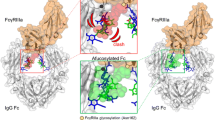Abstract
Glycation of therapeutic proteins occurs during mammalian cell culture expression and upon administration to patients. Since the chemical attachment of mannose or other sugars via a chemical linker has been shown to increase a protein’s clearance rate in mice through the mannose receptor, we explored the effect of mannose glycation on the clearance of an IgG in mice. An IgG decorated with high levels of mannose (~18 mol/mol protein) through glycation did not clear faster in mice than the underivatized protein, whereas the same IgG decorated with mannose attached in a way to maintain the normal glycosidic bond (2-imino-2-methoxyethyl-1-thiomannoside, or IMT-mannose) at similar derivatization levels cleared significantly faster. Surface plasmon resonance studies revealed that the IgG derivatized with IMT-mannose bound tightly to the mannose receptor (KD = 20 nM) but the IgG glycated with mannose did not bind. These results indicate that glycation, even at unnaturally elevated levels, does not appear to be a clearance concern for therapeutic proteins.






Similar content being viewed by others
Abbreviations
- AUC:
-
area under the curve
- BSA:
-
bovine serum albumin
- CHO:
-
Chinese hamster ovary
- CRD:
-
carbohydrate recognition domain
- IMT:
-
2-imino-2-methoxyethyl-1-thio-
- LC:
-
liquid chromatography
- mAb:
-
monoclonal antibody
- MR:
-
mannose receptor
- MRT:
-
mean residence time
- MS:
-
mass spectrometry
- PK:
-
phamacokinetics
- RU:
-
resonance units
- SPR:
-
surface plasmon resonance
References
Lee SJ, Evers S, Roeder D, Parlow AF, Risteli J, Risteli L, et al. Mannose receptor-mediated regulation of serum glycoprotein homeostasis. Science (New York). 2002;295(5561):1898–901.
Goetze AM, Liu YD, Zhang Z, Shah B, Lee E, Bondarenko PV, et al. High-mannose glycans on the Fc region of therapeutic IgG antibodies increase serum clearance in humans. Glycobiology. 2011;21(7):949–59.
Linehan SA, Martinez-Pomares L, Stahl PD, Gordon S. Mannose receptor and its putative ligands in normal murine lymphoid and nonlymphoid organs: In situ expression of mannose receptor by selected macrophages, endothelial cells, perivascular microglia, and mesangial cells, but not dendritic cells. J Exp Med. 1999;189(12):1961–72.
Taylor ME, Bezouska K, Drickamer K. Contribution to ligand binding by multiple carbohydrate-recognition domains in the macrophage mannose receptor. J Biol Chem. 1992;267(3):1719–26.
Llorca O. Extended and bent conformations of the mannose receptor family. Cell Mol Life Sci : CMLS. 2008;65(9):1302–10.
Opanasopit P, Shirashi K, Nishikawa M, Yamashita F, Takakura Y, Hashida M. In vivo recognition of mannosylated proteins by hepatic mannose receptors and mannan-binding protein. Am J Physiol Gastrointest Liver Physiol. 2001;280(5):G879–89.
Bucola R, Cerami A. Advanced Glycosylation: Chemistry, Biology, and Implications for Diabetes and Aging. Adv Pharmacol. 1992;23:1–33.
Goetze AM, Liu YD, Arroll T, Chu L, Flynn GC. Rates and impact of human antibody glycation in vivo. Glycobiology. 2012;22(2):221–34.
Koenig RJ, Peterson CM, Jones RL, Saudek C, Lehrman M, Cerami A. Correlation of glucose regulation and hemoglobin AIc in diabetes mellitus. N Engl J Med. 1976;295(8):417–20.
Austin GE, Mullins RH, Morin LG. Non-enzymic glycation of individual plasma proteins in normoglycemic and hyperglycemic patients. Clin Chem. 1987;33(12):2220–4.
Miller AK, Hambly DM, Kerwin BA, Treuheit MJ, Gadgil HS. Characterization of site-specific glycation during process development of a human therapeutic monoclonal antibody. J Pharm Sci. 2011;100(7):2543–50.
Zhang B, Yang Y, Yuk I, Pai R, McKay P, Eigenbrot C, et al. Unveiling a glycation hot spot in a recombinant humanized monoclonal antibody. Anal Chem. 2008;80(7):2379–90.
Kennedy DM, Skillen AW, Self CH. Glycation increases the vascular clearance rate of IgG in mice. Clin Exp Immunol. 1993;94(3):447–51.
Shukla AA, Hubbard B, Tressel T, Guhan S, Low D. Downstream processing of monoclonal antibodies—Application of platform approaches. J Chromatogr B Analyt Technol Biomed Life Sci. 2007;848(1):28–39.
Lee YC, Stowell CP, Krantz MJ. 2-Imino-2-methoxyethyl 1-thioglycosides: New reagents for attaching sugars to proteins. Biochemistry. 1976;15(18):3956–63.
National Research Council (U.S.). Committee for the Update of the Guide for the Care and Use of Laboratory Animals, Institute for Laboratory Animal Research (U.S.), National Academies Press (U.S.). Guide for the care and use of laboratory animals. 8th ed. Washington, D.C.: National Academies Press; 2011. xxv, 220 p. p.
Gustafsson A, Sjoblom M, Strindelius L, Johansson T, Fleckenstein T, Chatzissavidou N, et al. Pichia pastoris-produced mucin-type fusion proteins with multivalent O-glycan substitution as targeting molecules for mannose-specific receptors of the immune system. Glycobiology. 2011;21(8):1071–86.
Chen X, Flynn GC. Gas-phase oligosaccharide nonreducing end (GONE) sequencing and structural analysis by reversed phase HPLC/mass spectrometry with polarity switching. J Am Soc Mass Spectrom. 2009;20(10):1821–33.
Neglia CI, Cohen HJ, Garber AR, Ellis PD, Thorpe SR, Baynes JW. 13C NMR investigation of nonenzymatic glucosylation of protein. Model studies using RNase A. J Biol Chem. 1983;258(23):14279–83.
Rohovec J, Maschmeyer T, Aime S, Peters JA. The structure of the sugar residue in glycated human serum albumin and its molecular recognition by phenylboronate. Chemistry. 2003;9(10):2193–9.
Feinberg H, Park-Snyder S, Kolatkar AR, Heise CT, Taylor ME, Weis WI. Structure of a C-type carbohydrate recognition domain from the macrophage mannose receptor. J Biol Chem. 2000;275(28):21539–48.
East L, Isacke CM. The mannose receptor family. Biochim Biophys Acta. 2002;1572(2–3):364–86.
Acknowledgments
We thank Guna Kannan, John McCarter, Andy Goetze, and Diana Liu for helpful discussions, Michael Shearer, Kiani Maryam, and Toung-vi Don for technical assistance and Fuat Doymaz for statistics advice.
Author information
Authors and Affiliations
Corresponding author
Rights and permissions
About this article
Cite this article
Yang, J., Primack, R., Frohn, M. et al. Impact of Glycation on Antibody Clearance. AAPS J 17, 237–244 (2015). https://doi.org/10.1208/s12248-014-9694-4
Received:
Accepted:
Published:
Issue Date:
DOI: https://doi.org/10.1208/s12248-014-9694-4



